Family name: Pandanaceae R. Brown
Synonym(s): [none]
Common name(s): screw-pine family
*Number of genera/species: 5/982
List of genera records in GRIN-Global
fruit
Fruit a simple or multiple drupe or berryberry:
an indehiscent, fleshy fruit with one or a few to many seeds. The flesh may be homogenous throughout. Or, if the outer part is hard, firm, or leathery, referred to as an hesperidium. Septa are present in some, and the seeds may be arillate or with a fleshy testa.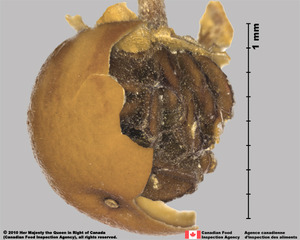 , 12–300 mm long, globoseglobose:
, 12–300 mm long, globoseglobose:
3D shape—more or less spherical to squaresquare:
to squaresquare:
2D shape—geometric figure bounded by 4 straight sides of equal length and 4 90º-angles
, tereteterete:
approximately circular in cross section; width and thickness approximately equal
 to angledangular:
to angledangular:
2D shape—having sides that meet at acute or obtuse angles
in transection, with one or many seeds. Drupedrupe:
(indehiscent drupe) a fleshy, indehiscent fruit with one more hard pits enclosing seeds, derived from single, superior, simple or compound ovary; (dehiscent drupe) a fruit with a dry or fibrous to fleshy or leathery outer husk that early to tardily breaks apart (or opens), exposing one or more nutlike pits enclosing the seeds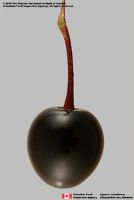 pericarp white, yellow, or orange to red, fibrousfibrous:
pericarp white, yellow, or orange to red, fibrousfibrous:
texture—long, flexible threads, thicker than hairs, that densely cover and obscure the surface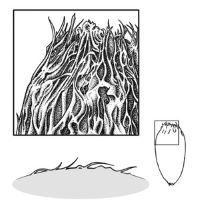 , fleshy, woodywoody:
, fleshy, woodywoody:
texture—consisting mainly of indurate lignified tissues, characteristic of or resembling wood
, indurateindurate:
texture—hardened or stony; yielding under strong pressure; not deformable without internal structural disruption
, or chartaceouschartaceous:
papery, papyraceous
, smooth, ribbedribbed:
surface relief—wide, prominent, linear ridges that are generally rounded and longitudinally situated on the surface , ridgedridged:
, ridgedridged:
surface relief—raised, thick ridges, sharp edged or rounded, usually in a series that may cover the entire surface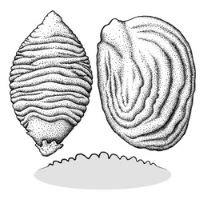 , pustularpustular:
, pustularpustular:
surface relief—with small blisters or pustules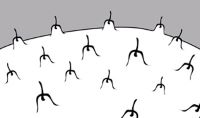 , or wartywarty:
, or wartywarty:
surface relief—distinct, rounded projections that are large relative to the fruit size; tuberculate, verrucose .
.
In Freycinetia, berriesberry:
an indehiscent, fleshy fruit with one or a few to many seeds. The flesh may be homogenous throughout. Or, if the outer part is hard, firm, or leathery, referred to as an hesperidium. Septa are present in some, and the seeds may be arillate or with a fleshy testa. are in heads of 10–10,000, fleshy or ligneousligneous:
are in heads of 10–10,000, fleshy or ligneousligneous:
woody
, with firm apicesapex:
the point farthest from the point of attachment, or the "tip" of an organ and fleshy bases, and many seeded. Sararanga also has berriesberry:
and fleshy bases, and many seeded. Sararanga also has berriesberry:
an indehiscent, fleshy fruit with one or a few to many seeds. The flesh may be homogenous throughout. Or, if the outer part is hard, firm, or leathery, referred to as an hesperidium. Septa are present in some, and the seeds may be arillate or with a fleshy testa. but with carpels in a distinctive biseriatebiseriate:
but with carpels in a distinctive biseriatebiseriate:
arranged in two rows; e.g. seeds arranged in two rows within a locule
sinuous row.
In the remaining genera, fruits are drupesdrupe:
(indehiscent drupe) a fleshy, indehiscent fruit with one more hard pits enclosing seeds, derived from single, superior, simple or compound ovary; (dehiscent drupe) a fruit with a dry or fibrous to fleshy or leathery outer husk that early to tardily breaks apart (or opens), exposing one or more nutlike pits enclosing the seeds often produced in a head and free to connate. Seeds are bound to the endocarpendocarp:
often produced in a head and free to connate. Seeds are bound to the endocarpendocarp:
the inner layer of the pericarp, if divided into layers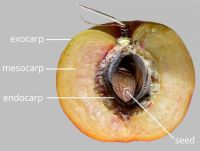 and germinating within the fruit. In Benstonea (formally Pandanus), drupesdrupe:
and germinating within the fruit. In Benstonea (formally Pandanus), drupesdrupe:
(indehiscent drupe) a fleshy, indehiscent fruit with one more hard pits enclosing seeds, derived from single, superior, simple or compound ovary; (dehiscent drupe) a fruit with a dry or fibrous to fleshy or leathery outer husk that early to tardily breaks apart (or opens), exposing one or more nutlike pits enclosing the seeds are free, monocarpellarymonocarpellary:
are free, monocarpellarymonocarpellary:
ovary or fruit having one carpel
, one seeded, and with stigmasstigma:
the portion of the pistil receptive to pollen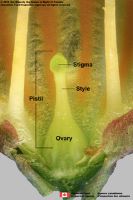 on the abaxialabaxial:
on the abaxialabaxial:
dorsal; on the side that is away from the axis (in nutlets, the side facing outwards); (compare adaxial) side of the persistent sharp, linearlinear:
side of the persistent sharp, linearlinear:
(shape) long, narrow, and uniform in width; (of embryo) embryo is straight and much longer than wide styles. In Pandanus, drupesdrupe:
styles. In Pandanus, drupesdrupe:
(indehiscent drupe) a fleshy, indehiscent fruit with one more hard pits enclosing seeds, derived from single, superior, simple or compound ovary; (dehiscent drupe) a fruit with a dry or fibrous to fleshy or leathery outer husk that early to tardily breaks apart (or opens), exposing one or more nutlike pits enclosing the seeds are free or connate, fibrousfibrous:
are free or connate, fibrousfibrous:
texture—long, flexible threads, thicker than hairs, that densely cover and obscure the surface , multicarpellate, several seeded, and with the stigmasstigma:
, multicarpellate, several seeded, and with the stigmasstigma:
the portion of the pistil receptive to pollen on the adaxialadaxial:
on the adaxialadaxial:
ventral; on the side that is towards the axis (in nutlets, the side facing inwards), (compare abaxial)
 side of the stylestyle:
side of the stylestyle:
in a flower, the narrow and elongated part of the pistil between the stigma and the ovary; sometimes persisting in fruit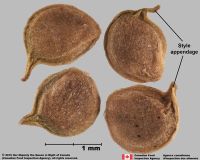 , which is variously shaped but rarely sharp and linearlinear:
, which is variously shaped but rarely sharp and linearlinear:
(shape) long, narrow, and uniform in width; (of embryo) embryo is straight and much longer than wide . In Martellidendron, drupesdrupe:
. In Martellidendron, drupesdrupe:
(indehiscent drupe) a fleshy, indehiscent fruit with one more hard pits enclosing seeds, derived from single, superior, simple or compound ovary; (dehiscent drupe) a fruit with a dry or fibrous to fleshy or leathery outer husk that early to tardily breaks apart (or opens), exposing one or more nutlike pits enclosing the seeds are in oblongoblong:
are in oblongoblong:
2D shape—much longer than broad with nearly parallel sides, corners are rounded , tubuliformtubuliform:
, tubuliformtubuliform:
having the form of a tube or cylinder
, or sphericalspherical:
3D shape—globose
heads, with two opposite stigmasstigma:
the portion of the pistil receptive to pollen at the apexapex:
at the apexapex:
the point farthest from the point of attachment, or the "tip" of an organ forming a cross with staminodesstaminodes:
forming a cross with staminodesstaminodes:
a modified, sterile stamen
at the base.
Seeds variable depending on the genus. In Sararanga and Freycinetia, seeds are small, compressedcompressed:
flattened; in grasses, used to denote compression (not necessarily flattened) either laterally or dorsiventrally
, straight, sometimes curvedcurved:
(of embryo) linear embryo is curved into an arch or horseshoe with the ends far apart in Freycinetia, with thick seed coats. Seeds in Freycinetia often develop what appears to be a strophiolestrophiole:
in Freycinetia, with thick seed coats. Seeds in Freycinetia often develop what appears to be a strophiolestrophiole:
appendage or outgrowth of seed coat near the hilum and micropyle
. In the other genera, seeds are larger, fusiformfusiform:
spindle-shaped; broadest at the middle and tapering at both ends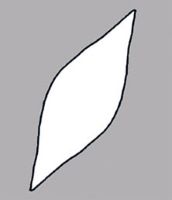 to obovoidobovoid:
to obovoidobovoid:
3D shape—obovate
, compressedcompressed:
flattened; in grasses, used to denote compression (not necessarily flattened) either laterally or dorsiventrally
, with thin, membranousmembranous:
texture—extremely thin, pliable, and fairly tough
seed coats.
Embryo well developed, small, linearlinear:
(shape) long, narrow, and uniform in width; (of embryo) embryo is straight and much longer than wide , straight.
, straight.
Endosperm copious, fleshy.
| Fruit | |
| Type | berryberry: an indehiscent, fleshy fruit with one or a few to many seeds. The flesh may be homogenous throughout. Or, if the outer part is hard, firm, or leathery, referred to as an hesperidium. Septa are present in some, and the seeds may be arillate or with a fleshy testa.  , drupedrupe: , drupedrupe:(indehiscent drupe) a fleshy, indehiscent fruit with one more hard pits enclosing seeds, derived from single, superior, simple or compound ovary; (dehiscent drupe) a fruit with a dry or fibrous to fleshy or leathery outer husk that early to tardily breaks apart (or opens), exposing one or more nutlike pits enclosing the seeds  |
| Size range | 12–300 mm long |
| Shape(s) | cylindricalcylindrical: 3D shape—a cylinder, with parallel sides and a circular cross-section; tubular or rod-shaped , ovoidovoid: 3D shape—ovate  , globoseglobose: , globoseglobose:3D shape—more or less spherical  , angularangular: , angularangular:2D shape—having sides that meet at acute or obtuse angles , ellipsoidellipsoid: 3D shape—elliptic , triangulartriangular: 2D shape—three relatively straight sides with distinct corners; more angular than teardrop-shaped  , squaresquare: , squaresquare:2D shape—geometric figure bounded by 4 straight sides of equal length and 4 90º-angles , ellipsoidellipsoid: 3D shape—elliptic |
| Texture | fibrousfibrous: texture—long, flexible threads, thicker than hairs, that densely cover and obscure the surface  , fleshy, woodywoody: , fleshy, woodywoody:texture—consisting mainly of indurate lignified tissues, characteristic of or resembling wood , chartaceouschartaceous: papery, papyraceous , indurateindurate: texture—hardened or stony; yielding under strong pressure; not deformable without internal structural disruption |
| Surface relief | smooth, ribbedribbed: surface relief—wide, prominent, linear ridges that are generally rounded and longitudinally situated on the surface  , ridgedridged: , ridgedridged:surface relief—raised, thick ridges, sharp edged or rounded, usually in a series that may cover the entire surface  , pustularpustular: , pustularpustular:surface relief—with small blisters or pustules  , wartywarty: , wartywarty:surface relief—distinct, rounded projections that are large relative to the fruit size; tuberculate, verrucose  |
| Color(s) | orange, red, white, yellow |
| Unique features | Often brightly colored, large drupesdrupe: (indehiscent drupe) a fleshy, indehiscent fruit with one more hard pits enclosing seeds, derived from single, superior, simple or compound ovary; (dehiscent drupe) a fruit with a dry or fibrous to fleshy or leathery outer husk that early to tardily breaks apart (or opens), exposing one or more nutlike pits enclosing the seeds  (falling singly or in multiples), angularangular: (falling singly or in multiples), angularangular:2D shape—having sides that meet at acute or obtuse angles , with fleshy to woodywoody: texture—consisting mainly of indurate lignified tissues, characteristic of or resembling wood pericarps. |
| Seed | |
| Size range | 3.2–15 mm long |
| Shape(s) | ovoidovoid: 3D shape—ovate  , triangulartriangular: , triangulartriangular:2D shape—three relatively straight sides with distinct corners; more angular than teardrop-shaped  , fusiformfusiform: , fusiformfusiform:spindle-shaped; broadest at the middle and tapering at both ends  |
| Surface relief | smooth, wrinkledwrinkled: surface relief—shallow, irregular folds and furrows covering the surface; appearing overall though crumpled and then spread out  , reticulatereticulate: , reticulatereticulate:surface relief—netted, raised walls or concave grooves forming a net-like surface pattern with flat, concave, or convex interspaces  , striatestriate: , striatestriate:surface relief—having fine, parallel lines, grooves or ridges  |
| Color(s) | black |
| Unique features | Black seeds, fusiformfusiform: spindle-shaped; broadest at the middle and tapering at both ends  to triangulartriangular: to triangulartriangular:2D shape—three relatively straight sides with distinct corners; more angular than teardrop-shaped  , compressedcompressed: , compressedcompressed:flattened; in grasses, used to denote compression (not necessarily flattened) either laterally or dorsiventrally , straight or curvedcurved: (of embryo) linear embryo is curved into an arch or horseshoe with the ends far apart  , with thin or thick coats. , with thin or thick coats. |
| Other | |
| Embryo | well developed, small, linearlinear: (shape) long, narrow, and uniform in width; (of embryo) embryo is straight and much longer than wide  , straight , straight |
| Nutritive tissue | endosperm copious, fleshy |
Paleotropics, with a few temperate species.
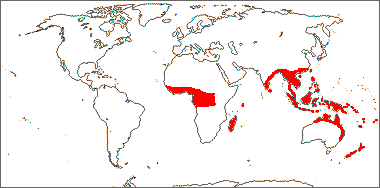
Distribution map courtesy of Angiosperm Phylogeny Website.
Baskin and Baskin 2021Baskin and Baskin 2021:
Baskin C and Baskin J. 2021. Relationship of the lateral embryo (in grasses) to other monocot embryos: A status up-grade. Seed Science Research 31 (3): 199-210. doi:10.1017/S0960258521000209; Beentje 1993Beentje 1993:
Beentje H. 1993. Pandanaceae. In: Polhill RM, ed. Flora of Tropical East Africa. Vol 136. AA Balkema, Rotterdam Netherlands. 9 pp.; Dahlgren et al. 1985Dahlgren et al. 1985:
Dahlgren RMT, Clifford HT, and Yeo PF. 1985. The families of the monocotyledons: structure, evolution, and taxonomy. Springer-Verlag, Berlin. 520 pp.; Flora of Australia 2021+Flora of Australia 2021+:
Flora of Australia. Australian Biological Resources Study, Canberra. Accessed January 2021–March 2024. URL: http://www.ausflora.org.au; Kirkbride et al. 2006Kirkbride et al. 2006:
Kirkbride JH, Jr, Gunn CR, and Dallwitz MJ. 2006. Family guide for fruits and seeds, vers. 1.0. Accessed September 2020-January 2022. URL: https://nt.ars-grin.gov/seedsfruits/keys/frsdfam/index.cfm .; Kubitzki et al. 1990+Kubitzki et al. 1990+:
Kubitzki K et al., eds. 1990+. The families and genera of vascular plants. 7+ vols. Berlin etc.; van Welzen 2011van Welzen 2011:
van Welzen PC. 2011. Pandaceae. Flora Malesiana 20: 15-43.; Zhengyi et al. 2004+Zhengyi et al. 2004+:
Zhengyi W, Raven PH, and Deyuan H. 2004+. Flora of China [online]. 25 vols. Science Press, Beijing China & Missouri Botanical Garden, St. Louis USA. Accessed January–March 2024. http://flora.huh.harvard.edu/china/
*The number of genera and species is based on Christenhusz and Byng 2016Christenhusz and Byng 2016:
Christenhusz MJM and Byng JW. 2016. The number of known plant species in the world and its annual increase. Phytotaxa 261 (3): 201-217. https://doi.org/10.11646/phytotaxa.261.3.1, which may differ from the number of genera in GRIN-Global.